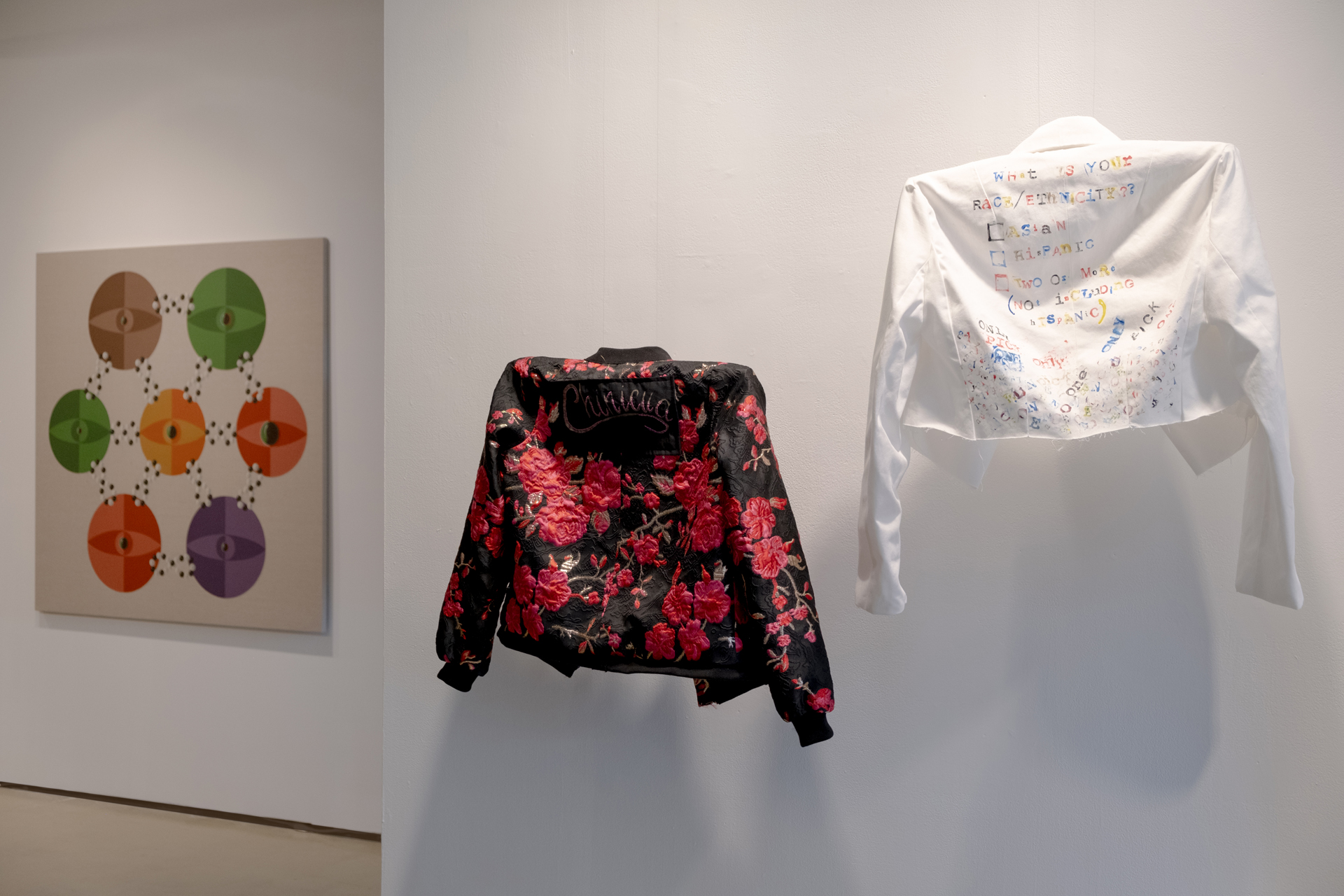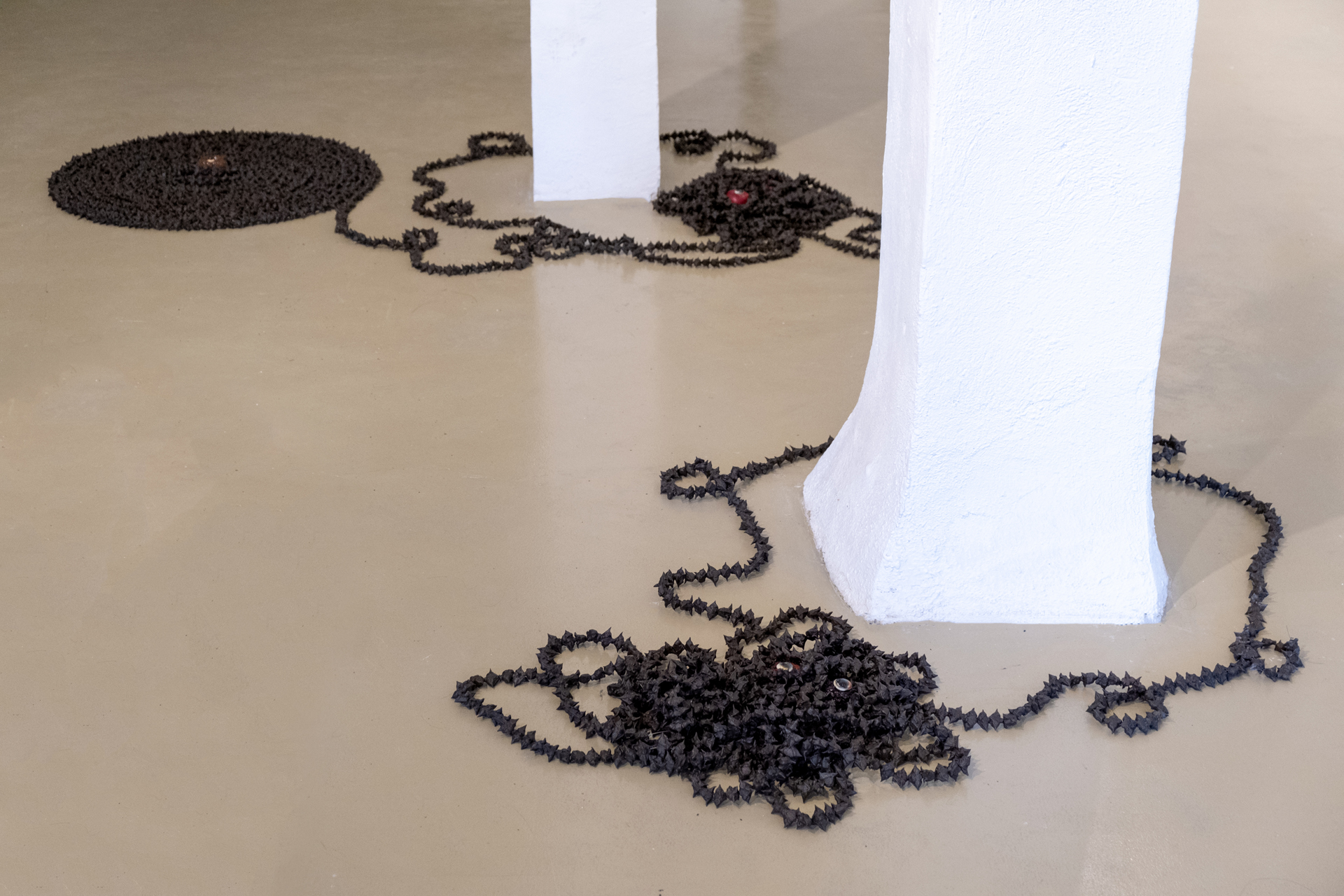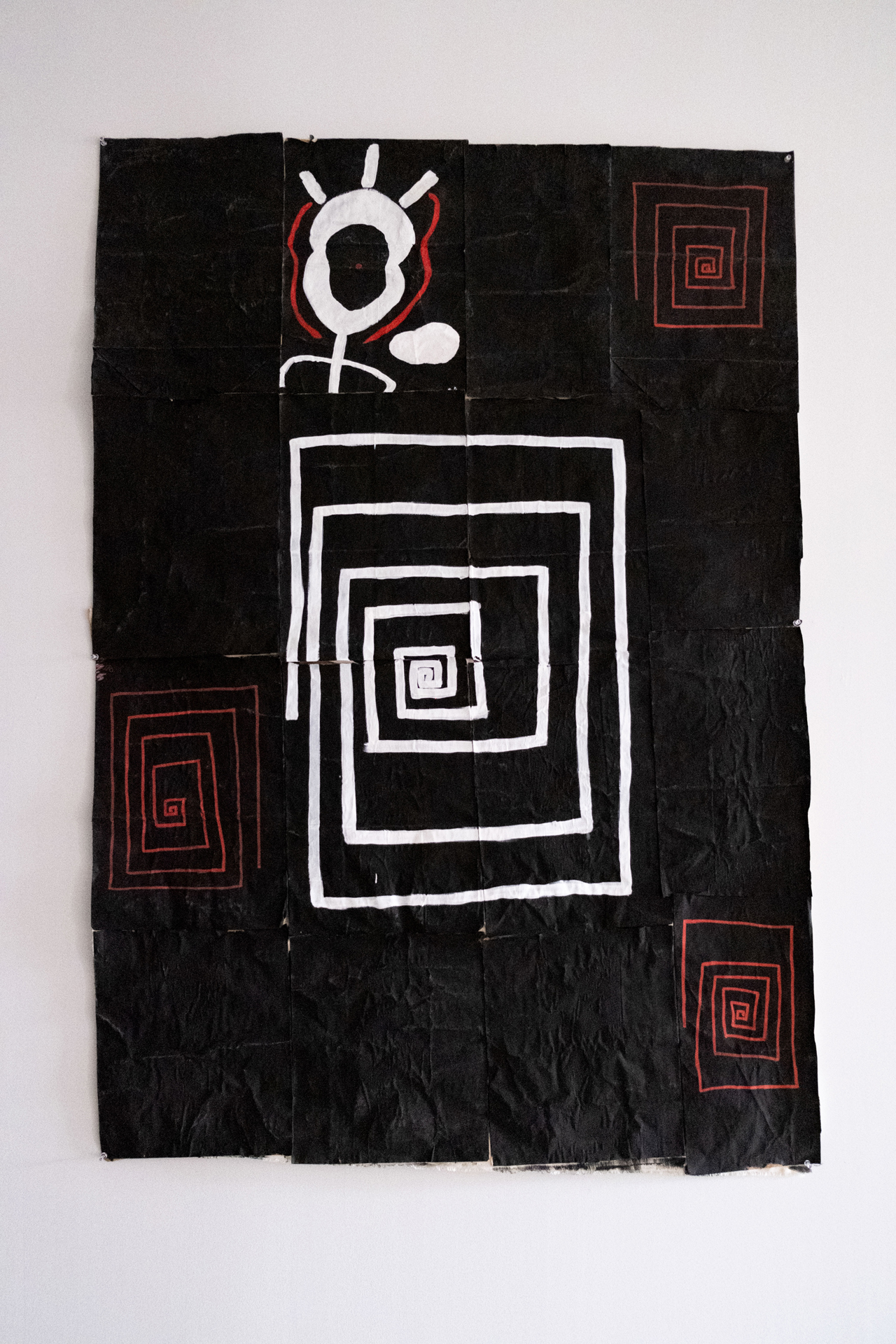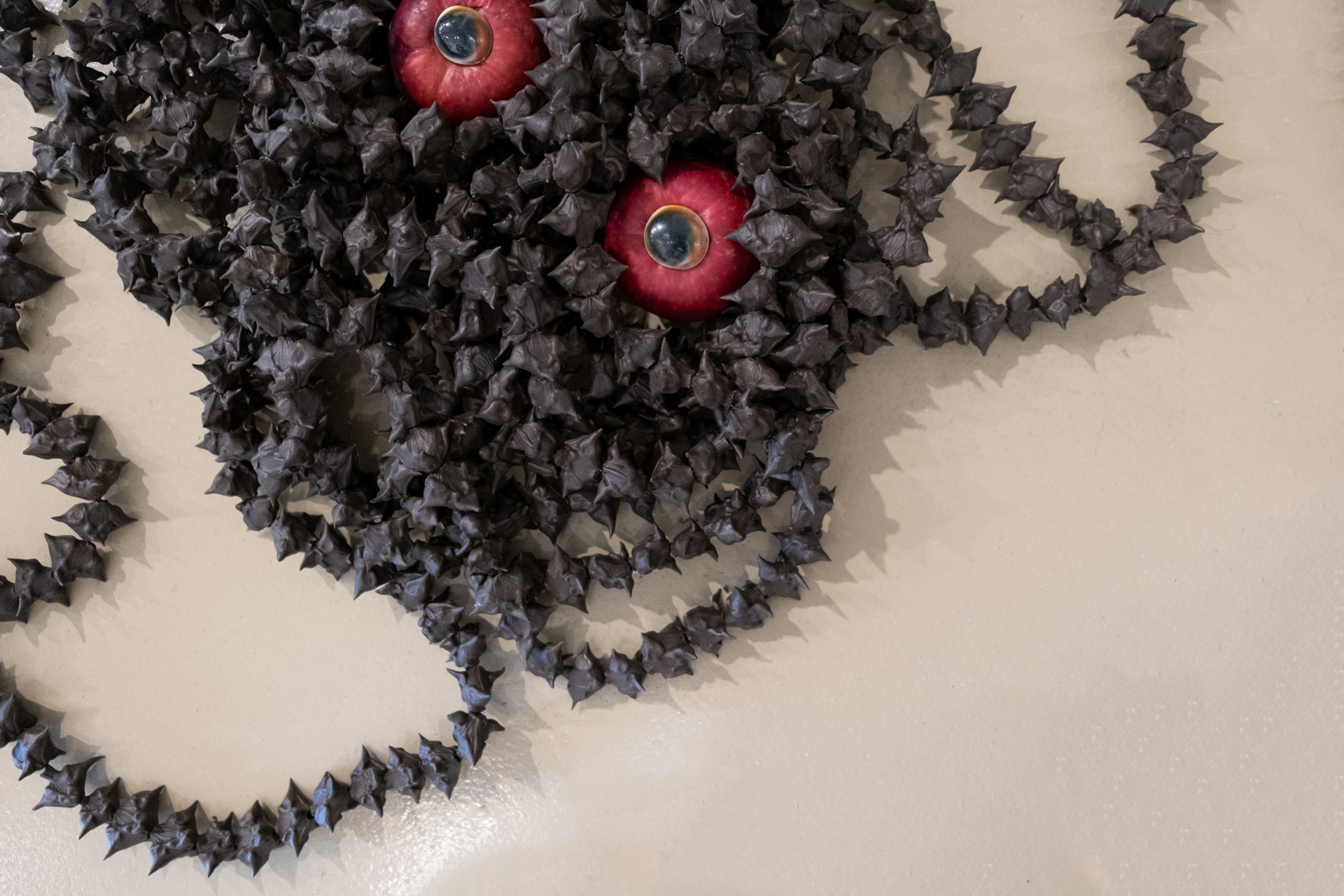Anthology
Emerging Artist Fellowship Exhibition 2022
September 22 - November 19, 2022Ann Street Gallery is pleased to present our first Emerging Artist Fellowship Exhibition, Anthology, opening this Thursday, September 22, 2022, featuring the work of Kammy Daydream, Myra Grice, Fernanda Mello, Neen Rivera, and Angelís Wong.
Anthology, a collective vision assembled together in the spirit of temporal togetherness—a term taken from theorist and artist Mieke Bal’s writing, Exhibition-ism, that proposes the act of exhibiting as the loci where art becomes contemporary in the company of visiors and an audience. The “being-together-in-time of an exhibition” serves as a place of confluence, where artists’ work come alive in the context of the gallery and in the context of each other’s co-existence and presence.
The work collaboratively presented for this inaugural Ann Street Gallery Emerging Artist Fellowship reflects our current moment, a signal of continued solidarity in the post-2020 aftermath where togetherness may still feel strange or taboo. Each artist’s identity—as BIPOC+ and Latinx—revalidates the local artist community, and breathes contemporaneity by mirroring the cultural production of the larger population of Newburgh, revealing sub-currents which flow through our city as a whole.
In this Anthology of work lies an exploration of pre-colonial consciousness, a drawing from deeper knowledge inside/outside of one’s self, an abstraction or representation of ones connection to one’s (urban/natural) environment, a navigation of race through clothing or color or form.
Exhibition Materials:
Exhibition Checklist
The image gallery to the right contains a selection of artwork from the exhibition.
Learn more about our 2022 Fellows & Fellowship program here.

















Kammy Daydream
Newburgh-born and raised, KAMMY DAYDREAM, brings his highly graphic, exuberant portraits showcasing a mastery of classic cartoon and pop art style. Peering through the prismatic facades, we come faced with a deeper sense of angst, a narrative of struggle and ability to overcome.
https://www.facebook.com/KammyDaydream/
@kammydaydream



Myra Grice
My name is Myra, I am a Black and Indigenous woman who was born and raised here in Newburgh, NY. My art subsequently is the embodiment of my surroundings, the fullest reflection of the town’s culture passed down to me from my parents who also grew up here. My father did a lot of graffiti back in the 80’s and I was surrounded by the black artistry that is graffiti. The amount of photography and books of art I was surrounded by due to him has followed me, and helped me create my own path as an artist too. The things I’ve been told and shown, and grown up through will always be in my art, whether I like it or not. I use the influence of 80’s graffiti in my abstract paintings to reflect the tone for each period of time in my life. And documented many feels and hardships in each work, whether a simple doodle on page or quick paint sketch. But, I always use the material around me. I don’t always have the means or options for material so I’ve grown used to using recycled materials at hand. Nothing is useless and can always be used for me. I believe anything can be a canvas.
Speaking to her history immersed as a child in the 80s Graffiti scene, Myra Grice’s large raw canvases of abstracted forms strike in a restricted palette of Black, Red & White. Her scavenge/salvage mentality reflected in the grainy static emanating from an old VCR screen atop a stand of crates.



Fernanda Mello
Olho d’ água (in brazilian portuguese meaning water sources that burst from
the soil) is a body of work that investigates Lenape migration, and coloniality of the Hudson River reflecting on questions such as: When did water stop being a blessing to be a resource? When did the Hudson River stop being called Mahicannituck (The river that runs both ways)? When did the River start showing its first signs of disease? After spending months foraging water chestnuts - an invasive species of seed pods from Asia that arrived in the Hudson river in the 19th century as a metaphor to place, Land Acknowledgement and Indigenous Sovereignty in the Newburgh historic area, Mello created these water creatures made with foraged objects that are called “Olho d’água” - they pass through the world with their seashell eyes, witnessing what has gone and what has remained in this land. They invite us to stare at what remains by reimagining what it means to be replaced. It also called for us to rethink regenerative ways of living and perceiving nature inspired by the 7th generation philosophy of Iroquois people.
Drawing from indigenous spiritual wisdom inspired from the Amazon of her native Brazil, Fernanda Mello weaves a poetic translation of the symbolic within the local, using found material tied to the Hudson River in her installations. Fluidly moving between sculpture and painting, she creates a pattern language of meditative and hypnotic forms that question our relationship to nature and place.
https://www.thevalleytaos.com/fernanda-mello
@thevalleytaos



Neen Rivera
This body of work is a celebration of the traditions, foods, and symbols of the Taino ancestors of Boriken (Puerto Rico). Vejigante masks are a symbol of resistance on the island. Right now there are many issues with colonialism, gentrification, and preplanned lack of resources. When the Puerto Rican flag is shown in black and white it is also a symbol of resistance. So by combining these two symbols it exemplifies how serious the need for resistance is. The other Vejigante mask in this exhibition is adorned in coconut husks alluding to the traditional mask making, and its horns wrapped in vines from my abuelas backyard.
The ceramic Trigonolito is an aupsized version of sculptural relics that were ritualistically blessed and buried with crops to promote a bountiful harvest. I am currently experimenting with a way to form reproductions of this sacred relic using soil/nutrients/seeds. This act references the traditional ritual and enhances them with modern farming technology to promote plant growth. I plan to work with local nature organizations in Newburgh such as the Urban Food Farm to collaborate on what these seeded Trigonolito should be made of to best serve this environment and where to plant them.
The ceramic serving bowls are recipes from my modern day Puerto Rican household that I wish to share with those who experience the work, through a series of gatherings. Our rice is made with sofrito (a spice blend with fresh peppers and spices) , and green pigeon peas (gandules). The rice and beans are accompanied by two types of platanos (fried plantains). Maduros are made by using plantains that are very overrippened, almost moldy (when they are at their sweetest). Tostones are twice smashed plantains that are sourced while still green/firm. There is also the famous cocktail (that I only recently discovered is from Puerto Rico) the pina colada. In this version I use a non alcoholic smoothie that I incorporate into a breakfast smoothie bowl. While mango salsa may not be inherently Puerto Rican it is a staple in my household and would’ve been terribly missed if omitted. Each of the pieces’ backside color was done using natural dying, not a ceramic process. I am hoping to use this experimentation into developing an established technique to combine natural dying and ceramics. The plants used in this natural dying are marigold, indigo, and madder roots.
The final components of this collection are my digital drawings and wire sculptures that depict an “eye”. I discovered it while researching Taino cave symbols. The original drawing was a circular eye that connects to a mouth with a straight line. I experimented with the form by making the eye more almond shaped , as well as adding curvature to the line, this introduces a nose-like shape to the composition and enhances the sense of emotion and visual movement.
The title of my exhibit is a commentary on the struggles I and many other queer Latinx people encounter in expressing our identity. The use of the term Boriquan, as opposed to Boricua is a way to question this tradition and create gender neutral options within the heavily gendered hispanic language.
Boriquan artist Neen Rivera uses their work as a platform to navigate identity and bring awareness of social injustice. Their practice explores different mediums as expression of the myriad facets of their life—from glazed recipe bowls to full scale wire-sculptures, each work takes its own shape, its own symbology.
https://neen-sculpture.square.site/
@neensculpture

Angelís Wong
My intertwined fashion series is full of handmade garments inspired by my Puerto Rican and Chinese backgrounds. The garments and custom fabrics were created to show the narrative of growing up as a mixed-race woman. I took inspiration from traditional Chinese and Puerto Rican clothing and some styles from the 1990s to the present. I also incorporated colors from both flags as a tribute to both ethinicities. Creating clothing based on my background helps me to connect to my family while also learning more about who I have become. Over the years, I taught myself how to sew by hand and by machine. I feel that creating everything by hand gives a sense of power and delicacy to my series.
Angelís Wong’s line of garments embody her mixed-race background uniting both Asian and Latinx heritages. Each piece traces a lineage, defining an identity manifest as second skin. The clothing—its material, texture, form–not only representing and reclaiming history but also projecting forms for the future.
https://amwong128.wixsite.com/angeliswong
@a.wong.art



Return to the Fellowship Directory
We thank our partners, mentors, advisors, and collaborators in the fellowship program:
Vernon Byron, Jonette O’Kelley Miller, & Alvalia Pemberton
The Ann Street Gallery Emerging Artist Fellowship is generously supported in part by:
Vernon Byron, Jonette O’Kelley Miller, & Alvalia Pemberton
The Ann Street Gallery Emerging Artist Fellowship is generously supported in part by:
